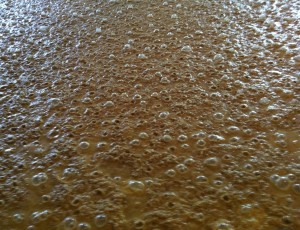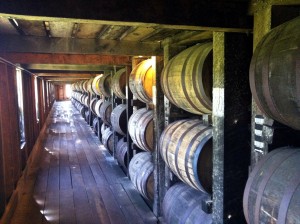“Whiskey” literally means water of life. The term refers to a broad category of products distilled from grains and aged in oak casks or barrels. Whiskeys are produced primarily in the US, Canada, Scotland, and Ireland. A few are made in Australia, England, Finland, Germany, India, Japan, Sweden, and Wales but are not commonly available in the US.
The spelling whisky (whiskies) is generally used in Canada and Scotland. The spelling whiskey (whiskeys) is more common in Ireland and the US. Whiskey is made in the following manner:
1. MASHING
Making whiskey begins with large quantities of grain. Grains (except barley) are first ground into a meal then mixed with water and cooked to break down cellulose walls that contain starch granules.
Barley is not cooked, it is malted. First it is soaked in water until thoroughly saturated, then it is spread out and kept moist until it sprouts. The enzyme diastase in produced during this germination which converts starch in the barley into sugars. Sprouting is halted by heating the barley with hot air from a kiln to dry it. Adding peat to fuel in the kiln gives the resulting product a smoky taste. The malted barley is then ground like other grains.
Cooked grain is mixed with malted barley and warm water, Diastase in the malted barley converts starch into sugars and after several hours the mixture becomes a sugar-rich liquid known as mash. Malt whiskey is made entirely from malted barley. Grain whiskey is made from malted barley along with other grains.
2. FERMENTING
The mash is then fermented. Sweet mash means the fermentation is started with fresh yeast. Sour mash means part of a previous fermentation is added to a new batch as a starter to get the process going. Yeast consumes sugar and produces alcohol and carbon dioxide. To the yeast, these are waste products; its mission is to consume sugar and reproduce. In a batch of bread, the CO2 causes bread to rise and the alcohol evaporates. In a grain mash, CO2 evaporates and alcohol accumulates until it reaches a 14%-18% concentration. The solution becomes toxic to the yeast at this point and it begins to die. Beer and wine can thus be made by fermentation alone. Distillation is required to achieve higher alcohol levels.
3. DISTILLING
The fermenting mash contains about 10% alcohol after three or four days and is next heated to boiling. The temperature of the distillation, among other factors, determines the proportions of water, alcohol, and other substances (aldehydes, acids, esters, fusel oils, and higher alcohols, collectively called congeners) in the vapor. Vapor is condensed back to liquid which now contains about 30% alcohol.
Some congeners are mildly toxic and have a strong disagreeable smell and taste. Distillers use charcoal, gravel, sand, or linen during secondary filtration to remove as many as possible, then distill the liquid again to raise its alcohol content to 70%. Some Scotch and Irish whiskies are distilled a third time to remove more impurities and improve flavor.
Tennessee Whiskey is filtered one or more times through ten feet of sugar-maple charcoal at this point to produce a particular taste.
Finally, water is added to reduce alcohol content to 50% for American whiskeys and about 65% or higher for Scotch whisky.
4. AGING
Whiskey is aged in wooden barrels usually made from white oak. This wood holds liquid without leaking and also allows water in the whiskey to move back and forth within the wood’s pores. Charring the inside of barrels makes substances in the wood more soluble in water. In the US the barrels are new and, for making bourbon, used only once to achieve a consistent flavor. Other countries reuse barrels.
The mixture of water, alcohol, and congeners in the distillate react with each other over time and oxidize with air. Water absorbs substances from the wood as it moves through the wood’s pores. This continuing process gradually develops and improves the flavor.
Whiskey generally takes three to four years to mature though many brands are aged ten to twenty years. Whiskey gains up to 60% of its flavor from the cask used in the aging process. The longer it is in the barrel, the more it tastes like the barrel. Whiskey does not continue to age in the bottle. A 21-year-old whiskey is still 21 years old however long it has been on your closet shelf.
5. BLENDING
Different batches of whiskey are mixed together to achieve a flavor characteristic of the brand. Sometimes neutral grain spirits, caramel, sherry, port, or other ingredients may be added to standardize the taste and color. The blending process is supervised by master blenders to produce a final product with the proper taste.
Single malt, generally the most desirable, is malt whiskey from a single distillery. It contains whiskey blended from different casks and different years from that distillery to obtain a particular taste. If a whiskey is made from only one cask and is not blended, it is labeled single-cask, single-barrel, cask-strength, or barrel proof and does not have an exactly predictable taste.
Vatted malt is a blend of malt whiskeys from different distilleries. A product labeled malt, blended malt, or pure malt is certain to be a vatted whiskey.
Blended whiskeys are made from a mixture of malt and grain whiskies usually from many distilleries, often along with neutral grain spirits, caramel, and flavoring. A product described only as Scotch or Irish whiskey with no other distinction is most likely such a blend.
6. BOTTLING
Distilleries use automated machinery to produce up to 400 bottles of whiskey per minute. Glass bottles, which do not react with the whiskey and change its flavor, move down a conveyor belt where they are cleaned, filled, capped, sealed, labelled, and placed in cardboard boxes for shipment.
Very little of the materials used during the whiskey-making process is wasted. Remaining fermented mash is processed into animal feed and even breakfast cereal. Charcoal used for filtration is pressed into briquettes. Used barrels are often sold to overseas distillers.
______________
“They say some of my stars drink whiskey. But I have found that the ones who drink milkshakes don’t win many ball games.” — Casey Stengel
“Always carry a flagon of whiskey in case of snakebite. Furthermore, always carry a small snake.” — W C Fields


